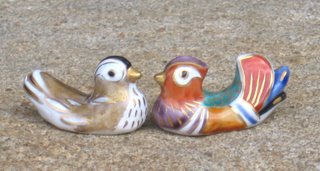11/26/2005
Faces beggar
INDIA SAIJIKI
..... INDIA SAIJIKI .....: Himalaya
:::::::::::::::::::::::::::::::::::::::::::::::::::::::::::::::::::::::::::::::::::::::::::::::::::::
. Beggars, begging and Haiku
[ . BACK to WORLDKIGO TOP . ]
:::::::::::::::::::::::::::::::::::::::::::::::::::::::::::::::::::::::::::::::::::::::::::::::::::::
11/19/2005
Harvest Festival
:::::::::::::::::::::::::::::::::::::::::::::::::::::::::::::::::::::::::::::::::::::::::::::::::::::
Harvest Festival (shuukakusai) in Ohaga

pounding rice -
steam rises from
the old mortar

smiling kids
with wooden food bowls -
harvest thanksgiving !
At the Ohaga Local School, November 19, 2005
Read more about it in my Ohaga BLOG
:::::::::::::::::::::::::::::::::::::::::::::::::::::::::::::::::::::::::::::::::::::::::::::::::::::
Kigo in this context:
Pounding rice (mochi tsuki)
Harvest Festival (Europe)
. Harvest and its Kigo
[ . BACK to WORLDKIGO . TOP . ]
:::::::::::::::::::::::::::::::::::::::::::::::::::::::::::::::::::::::::::::::::::::::::::::::::::::
11/15/2005
Bizen Pot
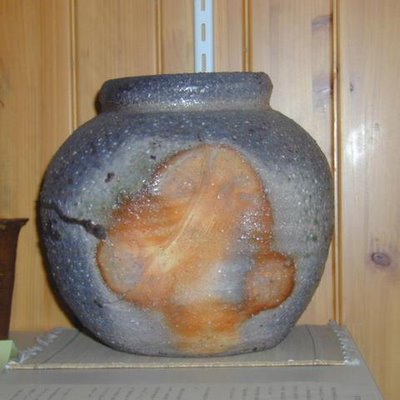 colors of nature born out of fire - autumn on my pot |
This vase is a type of gray bizen, a speciality of Mondo. It was fired in the large noborigama, the kiln on a hillside, and it takes 10 days to fire it. The orange is the direct reflection of the flames passing past the pot, as it lays sidewise during the firing.
Only very few pieces can be obtained in one kiln with this procedure.
I have written more details about Bizen Pottery.
... ... ... ... 高垣門土 - Takagaki Mondo
:::::::::::::::::::::::::::::::::::::::::::::::::::::::::::::::::::::::::::::::::::::::::::::::::::::
Read about my
Pottery and Haiku
:::::::::::::::::::::::::::::::::::::::::::::::::::::::::::::::::::::::::::::::::::::::::::::::::::::
[ . BACK to WORLDKIGO . TOP . ]
[ . BACK to DARUMA MUSEUM TOP . ]
:::::::::::::::::::::::::::::::::::::::::::::::::::::::::::::::::::::::::::::::::::::::::::::::::::::
Pottery and Haiku
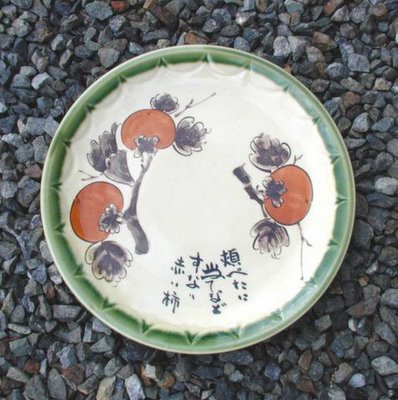 頬っぺたに 当てなどすなり 赤い柿 hoppeta ni ate nado sunari akai kaki red persimmons - try to hold them to your cheeks |
This is a large plate we use to serve entrees to our visitors.
. Persimmon (kaki) as KIGO

Listen to the delicious sound of autumn colors
:::::::::::::::::::::::::::::::::::::::::::::::::::::::::::::::::::::::::::::::::::::::::::::::::::::
My collection of Pottery and Haiku
New Sun <> Pottery and Poetry
Light or Shade, Praying Hands of Takagaki Mondo 高垣門土の作品
Bizen Pot and more by Takagaki Mondo
Zen Monks enjoying the Water of Wisdom
Mouse eats bread, Oil Dish
Mandala Plate from Tottori
More Pots and Plates from GokuRakuAn
and a bit of theory in my library:
'What's art and what's craft?'
:::::::::::::::::::::::::::::::::::::::::::::::::::::::::::::::::::::::::::::::::::::::::::::::::::::
In a whale’s eye
The glaze of a T'ang bowl –
Reflected!
source : Ian Watson 1975 : ‘The Jonah Kit’
:::::::::::::::::::::::::::::::::::::::::::::::::::::::::::::::::::::::::::::::::::::::::::::::::::::
haiku -
at the potter's wheel
clay of poetry
Gennady Nov
Joys of Japan, October 2012
:::::::::::::::::::::::::::::::::::::::::::::::::::::::::::::::::::::::::::::::::::::::::::::::::::::
[ . BACK to WORLDKIGO . TOP . ]
[ . BACK to DARUMA MUSEUM TOP . ]
:::::::::::::::::::::::::::::::::::::::::::::::::::::::::::::::::::::::::::::::::::::::::::::::::::::
11/14/2005
Light or Shade
 light or shade his praying hands steadfast |
The vase represents the hands of my husband, in Bizen pottery.
An object of my friend, Takagaki Mondo.
高垣門土の作品
祈りの手は主人の大きな手。
高垣門土の作品 - The World of Takagaki Mondo
***************************
Please send me your contributions
To the Daruma Museum Index
To the WHC Worldkigo Database
大垪和 道の駅 - My Village News
Shahai Haiga Illustrated poem
:::::::::::::::::::::::::::::::::::::::::::::::::::::::::::::::::::::::::::::::::::::::::::::::::::::
Illustrated Poems
They come under many different names now,
in Japan and outside of Japan.
:::::::::::::::::::::::::::::::::::::::::::::::::::::::::::::::::::::::::::::::::::::::::::::::::::::
Photo + Haiku ... Shahai 写俳
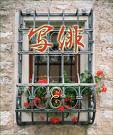
Some friends have asked me about haiku and photos, usually now called
Photo Haiku in the English language.
Haiga 俳画 are of course the ones painted by hand, where haiku and picture usually are drawn at the same time, when you can consider where to place each ... and usually the painter and the poet are of course one and the same person.
GA 画 means painting, drawing.
When I take a photo, I usually aim with the full frame to make a picture that is somehow complete in itself. Any text within would destroy this impression, so I started to write my text beside or above or below a photo. To enhance the unity of the work, I then make a frame with a color that should still more enhance the situation I want to express with both the photo and the haiku combined.
Many photo haiku I have seen with the text overlayed have one problem for me: The text is usually so small that it is hard to read. But it must be small so as not to distract too much of the photo. Or the text covers an important part of the picture.
Now the Japanese are sort of copying this Photo Haiku Concept and the new product is called
Sha-Hai
sha .. from shashin, photo 写真
hai, you guess, from Haiku 俳句
Sometimes it is also called haisha 俳写,
but that reading reminds many of a dentist ha-isha 歯医者
Since the spread of handy telephones with cameras, it is even more convenient to take a snapshot while you are going for a haiku walk. And post it while you are still out there on your walk.
Japanese shahai blogs are spreading like mushrooms.
The English term "photo-haiga" seems problematic, since in Japanese that would be
photo-haiku-painting フォト俳画.
photo haiku seems to fit better to the genre.
A painting is a different thing from a photo,
in the English language and in the Japanese language
different terms are used.
:::::::::::::::::::::::::::::::::::::::::::::::::::::::::::::::::::::::::::::::::::::::::::::::::::::
When composing a Photo-Haiku
it is best if the author of the photo and the poem is one and the same person.
You can start with a haiku and find a suitable photo for it.
You can start with a photo and try to compose a haiku for it.
The photo and haiku can closely match each other.
The photo and haiku can be of completely different subjects, but together give rise to a new short story.
If your photo definitely expresses the season, you might do without a kigo in your haiku.
If you quote a poem you find somewhere online or use a photo you find online, you should try and get permission of the original author to use his work.
The least you should do is give credit to the photografer/poet and quote the page from where you took that part of your composition.
Two authors (or more) are needed for a collaboration.
haiga koraboreeshon 俳画コラボレーション
Sometimes, you will publish the work under your own name, so make sure all the sources you used are properly credited.

source : Shanghai Explorer
水夫清画伯との俳画コラボレーション
:::::::::::::::::::::::::::::::::::::::::::::::::::::::::::::::::::::::::::::::::::::::::::::::::::::
The latest from NHK in Japan, for haiku, senryu and other short poems with the same rhythm
Five Seven Five with a Photo
NHK Foto Go Shichi Go
NHK is running an 8 series programm from November 2007 about
Foto Go Shichi Go / Photo 5 7 5
Photographer Itami Koji is giving advise.
板見 浩史(いたみ こうじ)

This is different from SHA HAI (haiku), in as much as it includes all forms of short poetry with the rhythm of five seven five (go shichi go). It is becoming quite popular now, since everyone has a cellphone with camera and can send his composition to his BLOG from everywhere in Japan.
five seven five is the rhythm of the Japanese soul,
as one Japanese poet has put it.
For more information, read
NHK Haiku, My Introduction
ENJOY !
フォト 五七五 foto 5 7 5 gallery with photos and poems, like a walk through an everyday of Japan ...
Just click on any photo to see more !
:::::::::::::::::::::::::::::::::::::::::::::::::::::::::::::::::::::::::::::::::::::::::::::::::::::
I add some LINKs to Japanese SHAHAI pages
写俳日記
http://shahai.exblog.jp/
写俳も楽しいものですね。♪
http://plaza.rakuten.co.jp/kyotocity/diary/200511100000/#comment
quite neon…
http://www.ne.jp/asahi/hai/ten/syahai-popona001.htm
klick on any of these clickables
http://www5a.biglobe.ne.jp/~HAIKU/wakwakf/ksyahaif.htm
Click on a photo to see the haiku above the photo and listen to music
Oboke gorge in Japan
http://www.st.rim.or.jp/~musasi/oboke.htm
Shahai Gallery
http://www.fujicom.co.jp/salon/circle/c_syahai.html
again with music
http://www.st.rim.or.jp/~musasi/index.htm
a book about HAI SHA
http://www.50pa.com/haisya.html
There are about 500 hits when googeling with 写俳。
So I give up for now. (November 2005)
google with 写俳 NOW !
about 25,800 for 写俳, November 2007
and 5,070,000 hits in June 2012
:::::::::::::::::::::::::::::::::::::::::::::::::::::::::::::::::::::::::::::::::::::::::::::::::::::
HAIGA 俳画
Should we pin "traditional Japanese haiga" versus
"modern haiga" including all other forms in English ?
How about the many illustrations generated by computers which are not photos?
And the many poems which are not haiku but included in an illustration?
The debate outside Japan goes on and on, including,
again, the definitions for haiku itself
and the inclusion of senryu, waka, tanka and other kinds of text within an illustration.
. WKD : Trying to define HAIKU ... .
- quote
A Brief History of Haiga
The form of poem-painting called haiga has been a medium of visual expression almost since the emergence of haiku poetry. We have no direct evidence of haiga’s first occurrence, but because a great number of haiku represent visual images, and also considering that poems and images in Japan were created with the same brush and ink, it must have been a natural step to add paintings to haiku. However, they are two very distinct forms of expression, with different capabilities and potentials, leading to a number of interesting questions. How did Japanese masters reconcile or play upon these differences? Most important, how did the addition of visual images reinforce, add to, or change the meanings of the poems?
Nonoguchi (Hinaya) Ryuho (1595–1669) is sometimes cited as the originator of haiga, in part because he inscribed upon one of his later scrolls that around the age of sixty he began a new practice of painting; whether or not he specifically meant haiga is not clear. His works, however, are not typical haiga because he usually adds considerably more text than just the haiku poem, and his calligraphy is not often visually integrated with the image.
Haiga, like haiku itself, became a major form of artistic expression with Matsuo Basho (1644–1694). His modest paintings do not seek to impress viewers with technical prowess, bright colors, or bold brushwork, but they set the tone for most haiga that was to follow. The most important later poet-artist was Yosa Buson (1716–1784) who was a master painter. Some of his scrolls go beyond the simplicity and modesty established by Basho, turning haiga into a more purely painterly medium. This led to two consequences. First, haiga became a form of art that was enjoyed by a larger audience than before. Second, haiga developed into a genre that could be practiced by professional artists, whether or not they were themselves poets. Nevertheless, haiku masters continued to add images to their poems, often in the most seemingly artless manner, and therefore we may see after the time of Buson two main streams of haiga: those by painters and those by poets. Haiga made jointly by a painter and a poet also became common, although the most unified works were usually created by a single person.
Certain features distinguish haiga from other forms of Japanese painting. First is visual simplicity. Although this simplicity may be less notable in the haiga of professional painters than in those by poets, it is still clear that the images tend to have more limited motifs, fewer brushstrokes, less detail, and more empty space than most other Japanese paintings. Second, the brushwork in haiga tends to be informal and modest, rather than precise and polished. Third, when colors are used, they are usually soft and unobtrusive instead of bright and bold. Finally, the calligraphy of the poem is almost always a prominent feature of the composition, completing the visual design rather than merely adding to it.
Haiga is still a young art in the West, but the principles established in Japan offer a good background for further experimentation and development. It will be fascinating to see how this art evolves in its new home.
source : Stephen Addiss, 2003
..........................................................................
たのしい俳画入門―古典技法から現代俳画まで
from traditional haiga to modern haiga
by
Shiraiwa Yoshikata 白岩義賢
Haiga kyookai 俳画協会 Haiga Association
俳画とは...what is a haiga?
source : www.haiga.com/
They feature exhibitions with "gendai haiga".
haiga in English
In haiga there are no difficult rules to be observed, but what is characteristic of them is the use of ink and brush, for depiction in lines and utterance through empty spaces.
by Sekiho Yabumoto sensei
http://www.haiga.com/english/EN_index.html
gendai haiga kyookai 現代俳画協会
sensei is Sakanoshita Takeshi 坂下毅
大阪市淀川区新高4-6-6
??? this needs to be verified
gendai haiga 現代俳画 "modern Haiga" in Japan
It does not seem to include "shahai" photos, since this has become a genre of its own in Japan.
. . . CLICK here for Photos !
haiga saijiki 俳画歳時記 saijiki with haiga

furusato haiga ふるさと俳画
haiga from the homeland / heartland

source : Hollywood-Miyuki
Hikida Shigeaki : Hohoemi Jizo
ほほえみ地蔵 Smiling Jizo
. Furusato and Haiku .
:::::::::::::::::::::::::::::::::::::::::::::::::::::::::::::::::::::::::::::::::::::::::::::::::::::
haiku with illustrations 俳句 イラスト
illustrations with haiku
illustrated haiku
illustrations with short poems
illustrations with text and poems
illustrations with free verse
visual haiku / visual poem

Click for more examples !
all and more are possible in English naming attempts.
As an artist,
be free to create what comes to your muse.
.................................................................................
Nioizuke 匂い付け... leave a whiff to smell
but do not show the thing that produces the smell ...
Advise to go with the haiga by Buson, father of the Haiga!
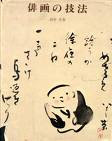
Haiga: A Definition
~ Ray Rasmussen
http://raysweb.net/haiku/pages/haiga-definition.html
Haiga Online Dot Com
Of all the contributions to world art to have come from the Japanese, haiga is perhaps the most unique. It is, by definition, a combination of visual and verbal elements which work in ensemble to create an aesthetic experience quite distinct from either element taken by itself.
Read all 20 pages here
Jim Kacian
"Looking and Seeing: How Haiga Works"
..... ..... .....
Haiga is haiku painting. REEDS on Haiga
:::::::::::::::::::::::::::::::::::::::::::::::::::::::::::::::::::::::::::::::::::::::::::::::::::::
yooga Yōga (洋画) Yoga
literally "Western-style paintings"
a term used to describe paintings by Japanese artists that have been made in accordance with Western (European) traditional conventions, techniques and materials. The term was coined in the Meiji period, to distinguish such works from indigenous traditional Japanese paintings, or Nihonga (日本画, nihonga).
© More in the WIKIPEDIA !
Exhibition Shiki and Art 正岡子規と美術

正岡子規《蔓草と鶏頭》1901年頃
Exhibition, Shiki and Art
Masaoka Shiki tried his own hand at yooga painting.
source : ponsan822
:::::::::::::::::::::::::::::::::::::::::::::::::::::::::::::::::::::::::::::::::::::::::::::::::::::
Gabi on haiga ...
question from a friend
Why do you write a haiku that is a close description, a duplicate of what the photograph is saying?
answer :
for me it works this way
If I read the story of Hansel and Gretel, for example, I expect the illustration of an old witch in a gingerbread home, not an elf dancing in moonshine.
If I see a photo that shows just what the haiku put in words, then I am happy (because a haiku for me is a snapshot in words) and I can now SEE the words were well choosen.
Nature presents us with a vista and we can capture it with words and as illustration. If both are rather similar, well, then both are well done!
If I had a haiku of an autumn lake in late sunshine with a photo for example of an airplain in the blue sky ... that would not work for me.
If we go on a ginko, a haiku walk, everyone sees the same landscape, but you would be surprized how many different haiku are written about it. Each is quite unique and shows the observand eye of each individual to a wide variety of objects in nature that could be used as a theme for a haiku of this moment.
:::::::::::::::::::::::::::::::::::::::::::::::::::::::::::::::::::::::::::::::::::::::::::::::::::::
. Etegami 絵手紙
Postcards with paintings and text
:::::::::::::::::::::::::::::::::::::::::::::::::::::::::::::::::::::::::::::::::::::::::::::::::::::
Computer-generated haiku illustrations
computer graphics and haiku

This one is also on our Fort Worth Haiku Society t-shirt

minimalist approach
Cliff has produced quite a lot of computer-generated haiku with illustrations.
Some are like a collage of various images.

origami frogs
no two alike --
amateur folder
Thank you, Cliff!
by Kawazu Cliff T. Roberts
:::::::::::::::::::::::::::::::::::::::::::::::::::::::::::::::::::::::::::::::::::::::::::::::::::::
More combinations of naming poetry, text and illustrations as they come up.
Please let me know your favorite !
Haiga 俳画 is a well-defined genre in Japan.
You can learn it if you are blessed with a good teacher.
If you want to depart from the basics, by all means.
As an artist,
be free to create what comes to your muse.
If it does not fit any category in your language,
just call it in a general way
"text (or poem) with illustration".

source : yaura_jap
HAIKU: Illustrated poems
Yukki Yaura
Suekichi Book
:::::::::::::::::::::::::::::::::::::::::::::::::::::::::::::::::::::::::::::::::::::::::::::::::::::
BACK TO
My Archives about Haiku Theory
[ . BACK to WORLDKIGO . TOP . ]
[ . BACK to DARUMA MUSEUM TOP . ]
:::::::::::::::::::::::::::::::::::::::::::::::::::::::::::::::::::::::::::::::::::::::::::::::::::::
11/13/2005
Sea of Clouds
:::::::::::::::::::::::::::::::::::::::::::::::::::::::::::::::::::::::::::::::::::::::::::::::::::::
yume no mata yume, this is a Japanese expression for something quite improbable.
Click here for more photos of this lovely morning
大垪和 ー 道の駅 My Ohaga Michi no Eki
Morning Walk 朝の散歩
雲海 Sea of Clouds, November 22, 2005
Clouds in my Valley 谷に雲
***************************
Please send me your contributions
To the Daruma Museum Index
To the WHC Worldkigo Database
11/10/2005
Autumn Leaves 2005
:::::::::::::::::::::::::::::::::::::::::::::::::::::::::::::::::::::::::::::::::::::::::::::::::::::
Look at my Autumn Album
Autumn Days 秋の天高し
Autumn Flowers 2002 秋の花
..... Autumn Flowers 2005 雨粒と花 Raindrops
..... Autumn 2005
Autumn Festival 2005 秋祭り、境神社
***************************
Please send me your contributions
To the Daruma Museum Index
To the WHC Worldkigo Database
11/06/2005
nagareboshi

nagareboshi 流れ星 nagareboshi - your life on earth just so short Sternschnuppe - dein kleines Leben viel zu kurz nagareboshi - a mother's tears a father's pain |
For a baby life lost too early !
Nagareboshi means shooting star in the sky.
Beginning of November 2005
:::::::::::::::::::::::::::::::::::::::::::::::::::::::::::::::::::::::::::::::::::::::::::::::::::::
Sai no Kawara, the Limbo for Children
Jizoo 地蔵 .. a smiling Stone friend of Children
. WKD : Shooting Star 流れ星 nagareboshi
:::::::::::::::::::::::::::::::::::::::::::::::::::::::::::::::::::::::::::::::::::::::::::::::::::::
11/01/2005
Morning Walk
 sea of clouds - a morning to welcome special guests ... ... ...  morning walk - the Dragon spits fire from the roof ... ... ...  far beyond the veiled world so far beyond |
:::::::::::::::::::::::::::::::::::::::::::::::::::::::::::::::::::::::::::::::::::::::::::::::::::::
Our visitor on this splendid autumn day
Gerhardt Staufenbiel
CHADÔ - DER JAPANISCHE TEEWEG
CHADÔ - THE JAPANESE WAY OF TEA
http://www.teeweg.de/
Look at his Shakuhachi Concert at GokuRakuAn
Look at my photo album of a great autumn day in
the Paradise Hermitage, GokuRakuAn 極楽庵
***************************
Please send me your contributions
To the Daruma Museum Index
To the WHC Worldkigo Database
Shakuhachi
 尺八や 秋の空に響きおり  shakuhachi ya the sound of autumn in my valley  shakuhachi ya the delicious sound of autumn colors  |
:::::::::::::::::::::::::::::::::::::::::::::::::::::::::::::::::::::::::::::::::::::::::::::::::::::
Our special guest on this splendid autumn day
The Tea Sensei Gerhardt Staufenbiel
CHADÔ - DER JAPANISCHE TEEWEG
CHADÔ - THE JAPANESE WAY OF TEA
http://www.teeweg.de/
CONTINUED >
Click here for our Morning Walk
. My Photo Album
SHAKUHACHI CONCERT 2005
Look at my photo album of a great autumn day in
the Paradise Hermitage, GokuRakuAn
Celebrating 10 years in Paradise
Gabi and Bernd
極楽庵にて10年あまり。。。
わが大垪和、道の駅
:::::::::::::::::::::::::::::::::::::::::::::::::::::::::::::::::::::::::::::::::::::::::::::::::::::
Read my article about
Shakuhachi 尺八 <> The Bamboo Flute
:::::::::::::::::::::::::::::::::::::::::::::::::::::::::::::::::::::::::::::::::::::::::::::::::::::
[ . BACK to WORLDKIGO . TOP . ]
[ . BACK to DARUMA MUSEUM TOP . ]
:::::::::::::::::::::::::::::::::::::::::::::::::::::::::::::::::::::::::::::::::::::::::::::::::::::














